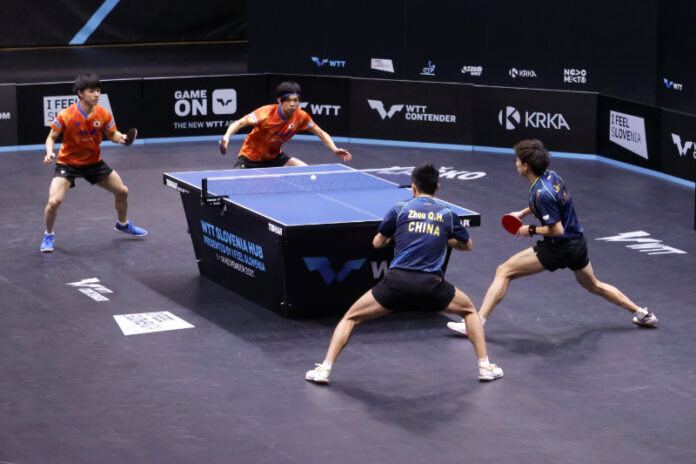
The sporting world has benefited greatly from the evolution of mobile and 5G, bringing live games to more people beyond the arena.
Table tennis is one sport harnessing new technology to enhance the experience for fans and players alike. For World Table Tennis (WTT), the organisation created by the International Table Tennis Federation (ITTF) to run commercialised tournaments, it’s crunch time.
The first and most pressing concern was ITTF’s historical records from the past 90 years, which WTT needed to organise. These records are divided into subcategories, such as Youth, Veteran, and Para Table Tennis, along with data on match officials and coaches.
Therefore, the organisation urgently needed a winning play: a single, immutable source of truth—a centralised data repository across various distributed systems.
Serving a winning strategy
For fans watching on TV or their mobile devices, the game alone isn’t enough. Real-time and historical data—like score sheets, player info, and statistical analysis—provide viewers with added context. Meanwhile, for broadcasters and sports analysts, quick and easy access to data enables more effective colour commentary.

According to Vatsan Ramasubramanian, Director of IT at WTT, ensuring the high reliability and timeliness of data transfers, especially for live events, was challenging.
“As live feeds of our matches reach a global audience through mediums such as broadcast, streaming and digital front-end platforms, it is critical that match footage and data are transmitted immediately, consistently and without disruptions. The varying nature of table tennis matches also meant that we needed to capture live match updates across all types of formats and competitions accurately as they happen,” he said.
Initially, WTT built a brand-new data infrastructure using a previous data management solution, making the integration of legacy ITTF systems and databases extremely difficult.
Conversely, the company built its internal systems from scratch, requiring a significant amount of developer effort, which proved unsustainable.
Traditionally, ITTF scoring was processed manually using an in-venue results system. This on-premises solution had to process match data before sharing it with other systems, rather than providing results in real time.
This led WTT to leverage Confluent’s data streaming platform.
“Since implementing data streaming with Confluent, we’ve successfully transferred high-quality match data at low latency to our global audiences, resulting in millions of dollars in revenue. Whether through our live feeds or other front-facing platforms like the WTT mobile application, WeChat, or television score bugs, delivering this information to our viewers in real time has made the sport much more engaging for fans,” Ramasubramanian remarked.
As a result of the instant data sync between its results system and the cloud, WTT can now share all its event-related information, such as scoring, match schedules, and player entries, in real time to web and mobile platforms worldwide.
“In just this year alone, we’ve managed 60 table tennis events, accounting for roughly 26,000 matches and around 800,000 data points captured through our system. That is a significant amount of data-driven insights, and this is only set to grow,” the Director of IT shared.
Play-by-play
Before deploying Confluent’s solution, WTT aimed to build a scalable and reusable data messaging service framework with minimum overhead costs for set-up and maintenance. This framework needed to cover all WTT and ITTF events and offer capabilities for potential licensing to other events.
“We worked closely with Confluent’s Professional Services team early in our partnership, and actively participated in workshops that addressed best practices when it came to setting up various architectural facts such as availability, scalability, maintainability, extendibility, and costs,” Ramasubramanian said.

To begin with, Confluent conducted a thorough assessment of WTT’s current architecture, providing insights into the table tennis organisation’s data sources, systems, data destinations, and challenges.
“We recognised the importance of standardising data formats to facilitate seamless data flow and processing across their organisation. Confluent-supported connectors and Kafka clients played a pivotal role in efficiently ingesting data into Confluent’s data streaming platform. This helped WTT create a central nervous system for streamlined data management,” said Deepak Ajmani, Vice President, APAC, Confluent.
According to Ajmani, real-time data processing was a key focus, enabling WTT to perform instant data analysis and enrichment before delivering it to various platforms.
“This feature greatly enhanced WTT’s ability to engage fans in real-time and share all their event-related information in real-time to web and mobile platforms worldwide,” Ajmani continued.
In addition, Confluent’s Professional Services Team worked closely with WTT to optimise the architecture and adhered to best practices, ensuring the system was both scalable and responsive. This, in turn, ensured that WTT’s systems could handle the demands of live events without delays.
Ramasubramanian elaborated on their challenge with data latency: “Our data originates from various sources across global markets, and we faced stringent service-level agreements for data consumption when working with external partners. Over the past three years, we’ve worked closely with Confluent to achieve sub-second latency effectively. We’ve been testing ways to improve data leveraging using Cluster Linking, Cosmos DB, and VNET with Microsoft Azure’s cloud. All tests have shown positive results so far, and we’re excited to unleash its potential once we’re out of the testing phase.”
Gold or nothing
The decision to partner with Confluent was a no-brainer, said Michael Brown, WTT’s Chief Financial Officer, since table tennis is a sport that needs fast and frequent data collection.
“For example, multiple matches take place at the same time during a single event. Some mass participation events can have up to 100 tables playing simultaneously, but the most common is between 8-16 tables. This means the amount of data being captured during such events grows by the second,” he explained.

Moreover, Brown shared that Confluent’s platform enabled WTT to extract key data insights across all their channels. This is said to have enhanced user experience, accelerated go-to-market timelines, and allowed for easy scalability of their infrastructure based on tournament schedules.
“As a fully managed data streaming platform, they also provided the necessary support to validate our requirements and future-proof our architecture, thereby reducing overhead costs,” Brown added.
Leveraging Confluent’s data streaming capabilities, WTT is eyeing to further integrate and train AI models using real-time sports data.
“By comparing historical data from archived matches with current on-ground events, we can deliver more precise and granular insights. This could include details such as ball placement, speed, and spin, or even predictions about how players will react in specific situations. Ultimately, this will offer viewers a more comprehensive and unique table tennis experience,” the CFO said.
WTT is also considering becoming one of the early adopters of Confluent’s Apache Flink, a standalone stream processing engine.
“With more efficient data integration and transfers of our live feed operations, we aim to aggregate all the information across our different internal and front-facing channels into a centralised sports data lake. This can then be fully maximised for audience engagement, retail, and ecosystem development opportunities,” Brown revealed.
Additionally, WTT is also exploring avenues like gamification, table-tennis-related NFTs, merchandising, and expanding its over-the-top streaming platforms.
Looking ahead, Confluent’s Deepak Ajmani anticipates the live sports streaming market will continue to expand within the sporting world.
“There’s a growing demand for interactive fan experiences and a need for a comprehensive digital ecosystem of data and content that can engage audiences beyond just sporting matches. Data streaming will increasingly play a pivotal role in the sports industry, making its most significant impact by connecting data pipelines across all aspects of the sporting experience and building real-time data insights around them,” he concluded.















